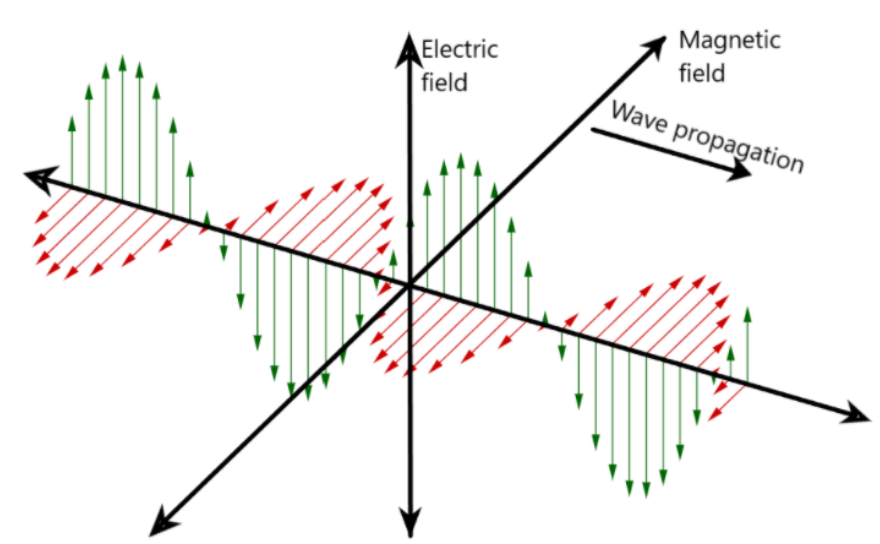
The sound waves are longitudinal waves. The electromagnetic waves are?
Answer
559.5k+ views
Hint: We know that there are different types of waves involved in our day-to-day observations. We need to understand the difference between the types of waves to understand and categorize the different waves into waveforms and study them properly.
Complete step by step solution:
We know that there are mainly two types of mechanical waves, which we come across in our daily experiences. The mechanical waves are the transverse waves and the longitudinal waves. Let us discuss each of them to understand the differences between them.
1.Transverse waves: These waves are those which travel perpendicular to the oscillation of the particles which cause the wave. The particles oscillate perpendicular to the direction of the wave as shown below.

The transverse waves do require a medium to propagate. The particle oscillations set the waves. Electromagnetic waves are a type of transverse wave, which doesn’t require a medium.

The oscillating charge produces the magnetic field and electric field in a mutually perpendicular direction, which is perpendicular to the wave propagation also. The electromagnetic waves are three-dimensional examples of transverse waves.
2.Longitudinal waves: These waves are those in which the particle oscillation is in the direction as that of the wave propagation as shown below.

The longitudinal wave propagation requires a particle medium for the wave movement. It propagates by creating areas of high pressure (compressions) and areas of lower pressures (rarefactions). This is not possible without a medium. The sound waves are examples of longitudinal waves.
We understand that electromagnetic waves are transverse waves as the sound waves are longitudinal.
This is the required solution.
Note: The electromagnetic waves are transverse waves, but they are mostly regarded as a special and different waveform due to its lack of interaction with particles and the remaining unsolved mysteries in the electromagnetic theories that explain them.
Complete step by step solution:
We know that there are mainly two types of mechanical waves, which we come across in our daily experiences. The mechanical waves are the transverse waves and the longitudinal waves. Let us discuss each of them to understand the differences between them.
1.Transverse waves: These waves are those which travel perpendicular to the oscillation of the particles which cause the wave. The particles oscillate perpendicular to the direction of the wave as shown below.

The transverse waves do require a medium to propagate. The particle oscillations set the waves. Electromagnetic waves are a type of transverse wave, which doesn’t require a medium.

The oscillating charge produces the magnetic field and electric field in a mutually perpendicular direction, which is perpendicular to the wave propagation also. The electromagnetic waves are three-dimensional examples of transverse waves.
2.Longitudinal waves: These waves are those in which the particle oscillation is in the direction as that of the wave propagation as shown below.

The longitudinal wave propagation requires a particle medium for the wave movement. It propagates by creating areas of high pressure (compressions) and areas of lower pressures (rarefactions). This is not possible without a medium. The sound waves are examples of longitudinal waves.
We understand that electromagnetic waves are transverse waves as the sound waves are longitudinal.
This is the required solution.
Note: The electromagnetic waves are transverse waves, but they are mostly regarded as a special and different waveform due to its lack of interaction with particles and the remaining unsolved mysteries in the electromagnetic theories that explain them.
Recently Updated Pages
Master Class 12 Business Studies: Engaging Questions & Answers for Success

Master Class 12 Economics: Engaging Questions & Answers for Success

Master Class 12 English: Engaging Questions & Answers for Success

Master Class 12 Maths: Engaging Questions & Answers for Success

Master Class 12 Social Science: Engaging Questions & Answers for Success

Master Class 12 Chemistry: Engaging Questions & Answers for Success

Trending doubts
What are the major means of transport Explain each class 12 social science CBSE

Which are the Top 10 Largest Countries of the World?

Draw a labelled sketch of the human eye class 12 physics CBSE

Explain sex determination in humans with line diag class 12 biology CBSE

The pH of the pancreatic juice is A 64 B 86 C 120 D class 12 biology CBSE

Give 10 examples of unisexual and bisexual flowers




